University of Nebraska Medical Center Accelerates Learning with Video

At the University of Nebraska Medical Center in Omaha, Nebraska, using technology to launch better learning, and therefore better health outcomes for patients, has become an integral part of the institution.
Kim Michael, Director of the Diagnostic Medical Sonography Program, says that Echo360’s video platform has been used in many programs at the college for close to ten years. Driven by student demand, it’s now a tool that is used widely in medical imaging. This provides students with more ways to re-watch recorded lectures and lab demonstrations and interact with course material for deeper learning.
“Our students can’t imagine learning without technology,” she explains, pointing to a total shift in the way that students in medical and health professional programs are consuming educational content.
Students Drive Video Platform Adoption in Large and Small Classes Alike
Video platforms are not just for use in large lecture halls anymore—in Michael’s program, class sizes are small, with the largest roster containing around 22 students.
Students attend classes in person unless there’s an emergency, of course. But they go back and re-watch recorded lectures for better understanding and clarity as they begin to prepare for exams. These students have come to appreciate and turn to this important tool for deeper comprehension. Like most students who are accustomed to classroom video platforms, UNMC students rely on recorded lectures and they object to instructors on the off chance a recording is unavailable.
Video Platforms Personalize Modern Learning
The versatility and flexibility of a video platform lets students integrate their education into their real lives, in addition to allowing students to learn at their own pace. This means, ultimately, that students are able to absorb course material more effectively and more completely, which is one of the hallmarks of modern learning.
For example, many UNMC students are also working professionals who depend on recorded lectures when their schedules dictate that they must attend certain classes online, or in hybrid form.
Furthermore, Michael says, medical imaging students find it particularly helpful to re-watch lectures in Physics classes, where they prefer to take notes to further their understanding of course material after class, when they have more time to reflect upon what they observed earlier, while they were sitting in class. The notes they take using the recorded lectures after class end up serving as organized study guides for exam time.
One student listens to recorded lectures on her commute to and from her clinical placement, as though it were a podcast. In this way, she and other students are able to maximize their time outside of class, continuing their learning on the go, from anywhere.
Video and Virtual Dissection: Blending Technologies for Advanced Learning
Most significantly for medical and health professional students are the ways in which a video platform tool can integrate with other high technology tools for learning. In laboratory sections, students often learn from virtual dissection tables, which help instructors teach students how to visualize different anatomy and pathology cases, and how to actually participate in dissections. One week, the students might identify the gastrointestinal system, for example, and determine whether a patient has a tumor inside her stomach, and what is happening with the surrounding structures.
“They can look at some of the critical structures around the tumor that you might not want to radiate,” explains Ms. Tanya Custer, Assistant Professor of Medical Imaging and Therapeutic Sciences. “And, if a patient has a tumor in the stomach, they’ll compare the anatomy from the patient to the normal system in the [virtual] cadaver.”
Blending the video platform with other in-class learning technologies like this means that students can review these important demonstrations with nearly as much clarity as they could when the demonstrations were happening in person.
Integrating Video Technology into Education Leads to Better Outcomes
The ability to analyze details and review case studies using video platform technology has positive implications that extend far beyond exam time, or even the school year—it translates into more highly trained health professionals. Most importantly, for patients, this kind of advanced learning eventually translates into better health.
Learn more how Echo360 can help improve student outcomes and is the smarter video platform.

